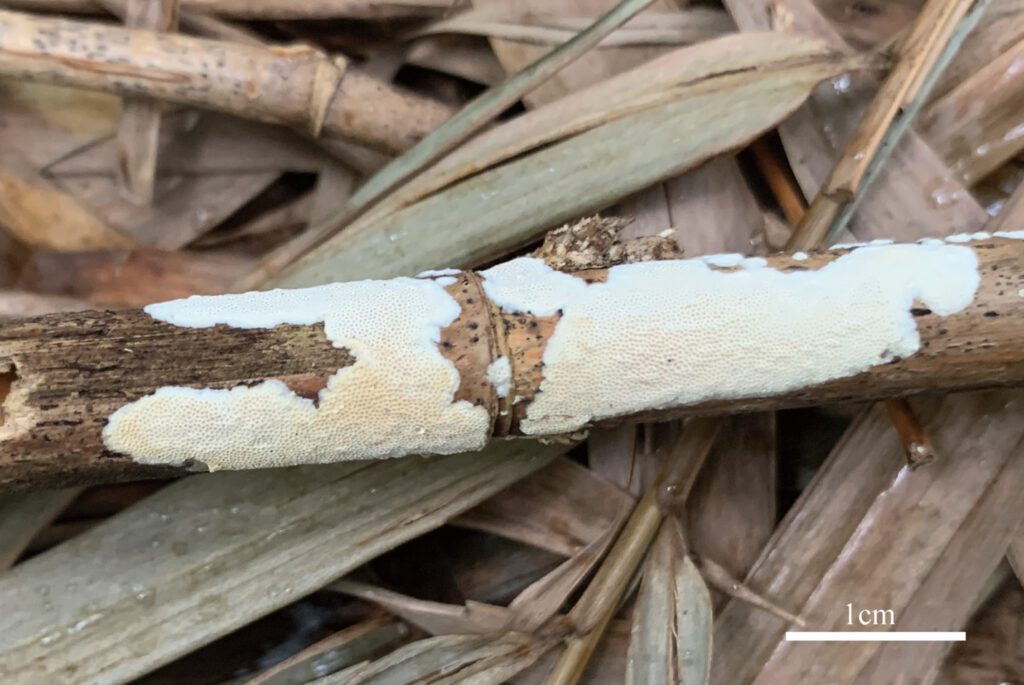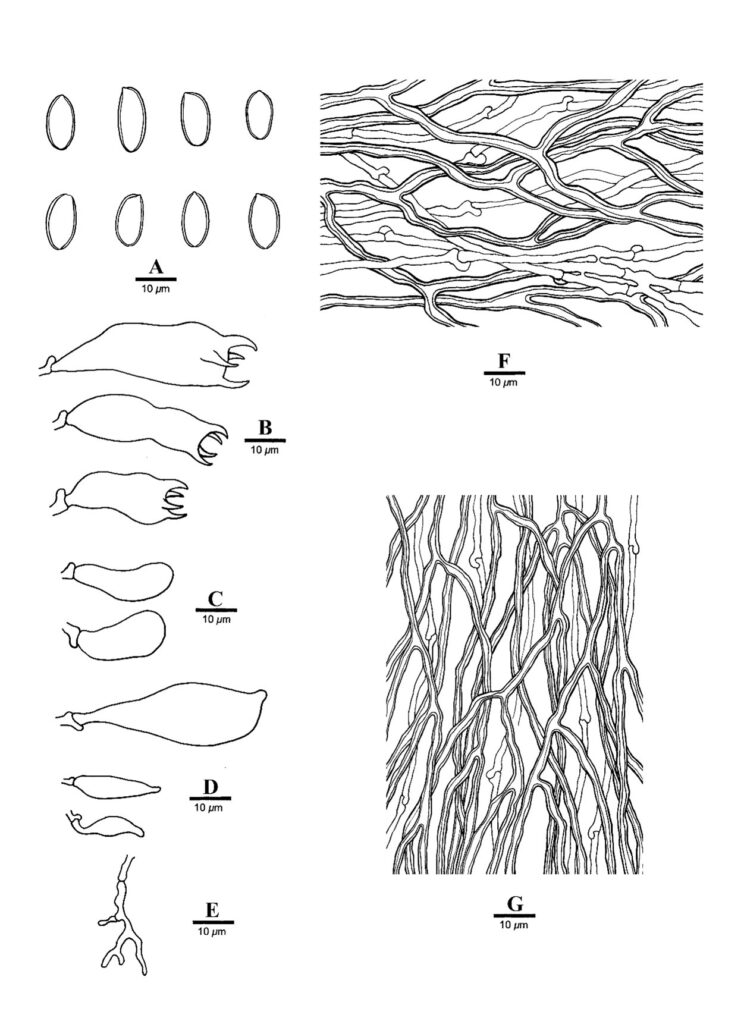Megasporia bambusae
MycoBank number: MB 558811; Index Fungorum number: IF 558811; Facesoffungi number: FoF 10470;
Description
Basidiocarps annual, resupinate, corky, without odor or taste when fresh, becoming hard corky upon drying, up to 2.7 cm long, 2.2 cm wide, and 0.2 mm thick at center; sterile margin distinct, white, up to 1 mm wide. Pore surface white to cream when fresh, cream to buff when dry; pores angular, 4–5 per mm; dissepiments thick, entire; subiculum pale buff, corky, up to 0.05 mm thick; tubes cream, paler than subiculum, corky, up to 0.15 mm long. Hyphal system dimitic; generative hyphae bearing clamp connections; skeletal hyphae weakly dextrinoid, CB+; tissues unchanged in KOH (not dissolved). Subicular generative hyphae hyaline, thin-walled, occasionally branched, 1.5–1.8 µm in diam; skeletal hyphae dominant, thick-walled with a narrow to wide lumen, frequently branched, mostly flexuous, interwoven, 2.5–3 µm in diam. Tramal generative hyphae hyaline, thin-walled, occasionally branched, 1.5–1.8 µm in diam; skeletal hyphae dominant, thick-walled with a narrow to medium lumen, frequently branched, mostly flexuous, interwoven, 1.5–2 µm in diam. Dendrohyphidia present. Hyphal pegs absent. Cystidia absent; cystidioles present, subulate or ventricose, thin-walled, smooth, 14–41 × 4.8–14.8 µm. Basidia clavate to pear-shaped, usually constricted in middle, with four sterigmata and a basal clamp connection, 20–35.2 × 10–14.8 µm; basidioles in shape similar to basidia, but distinctly smaller. Small tetrahedric or polyhedric crystals frequently present among hymenium. Basidiospores ellipsoid, hyaline, fairly thick-walled, smooth, IKI–, CB–, (10.5–)11.8–14(–14.8) × (5.5–)5.8–6.8(–7.5) µm, L = 12.67 µm, W = 6.53 µm, Q = 1.91–1.96 (n = 90/3).
Material examined: China, Hainan Prov., Haikou, Jinniuling Park, on dead bamboo, 18 Nov 2020, Y.C. Dai 22106 (BJFC035998, holotype), Y.C. Dai 22113 (BJFC036005); Guangxi Auto. Reg., Yulin, Guishan Forest Park, on dead bamboo, 3 Jul 2019, Y.C. Dai 20064 (BJFC031738).
Distribution: China, Hainan Prov., Haikou, Jinniuling Park.
Sequence data: Dai22106 (Holotype) – ITS: MW694884.1 (ITS5/ITS4); MTSSU: MW694912.1 (MS1/MS2); EF1a: MZ618631.1 (983F/1567R);
Dai20064 – ITS: MW694885.1 (ITS5/ITS4); LSU: MW694928.1 (LROR/LR7); MTSSU: MW694913.1 (MS1/MS2); EF1a: MZ618632.1 (983F/1567R);
Notes: Megasporia bambusae is found from the tropical zone of China. It is readily distinguished from other species in Megasporoporia sensu lato by its fairly thick-walled basidiospores and growing on bamboo, all other members of Megasporoporia sensu lato have thin-walled basidiospores and growing on dicotyledon.

Fig. 1. Megasporia bambusae (holotype). Basidiocarps of Megasporia bambusae (the holotype, Dai 22106).

Fig. 2. Megasporia bambusae (holotype). Microscopic structures of Megasporia bambusae (drawn from the holotype, Dai 22106). (A) Basidiospores; (B) Basidia; (C) Basidioles; (D) Cystidioles; (E) Dendrohyphidia; (E) Hyphae from subiculum; (G). Hyphae from tubes.
